How to Water Succulents in Pots without Drainage
There are some amazing planters and pots for succulents that don't have drainage holes. Find out how to properly water your succulents in one of them!
Succulents and Sunshine is reader supported. We may earn a commission, if you purchase through links on our site, such as Mountain Crest Gardens, Amazon, or Etsy. We only promote products we use and trust.
Figuring out how often to water your succulents can be tricky. But, it's usually even harder in pots without a drainage hole.
Succulents need their roots to dry out quickly.
They don't like to sit in water for more than a day or two and will begin to rot if they stay wet for much longer.
This is why I highly recommend using pots with a drainage hole when you are first starting out with succulents.
However, if you're growing succulents indoors, it's likely you want a pot without a drainage hole so you can keep your succulents on the counter and not worry about water coming out the bottom of the pot.
To help you master the art of watering succulents, start by downloading my free cheat sheet to see what it looks like when your succulents need more or less water. Click here to grab that that, it'll be super helpful.
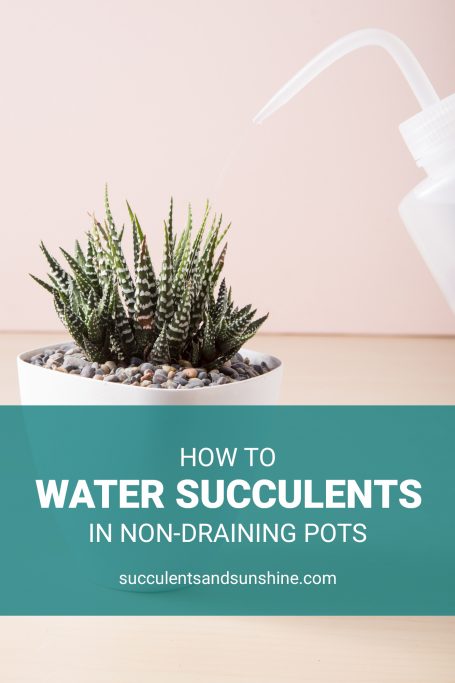
Let me tell you a few simple ways to make watering succulents in pots without a drainage hole easier.
Well-draining soil
Using a well draining soil is extremely important for pots without drainage because it allows for more airflow. Even though the water still has nowhere to flow out, it's easier for the water to evaporate if the soil has large particles (1/4″ or 6mm is ideal).
I generally use the gritty mix from Bonsai Jack, however, I also frequently use pumice in glass containers. The pumice tends to look a little cleaner in the glass.
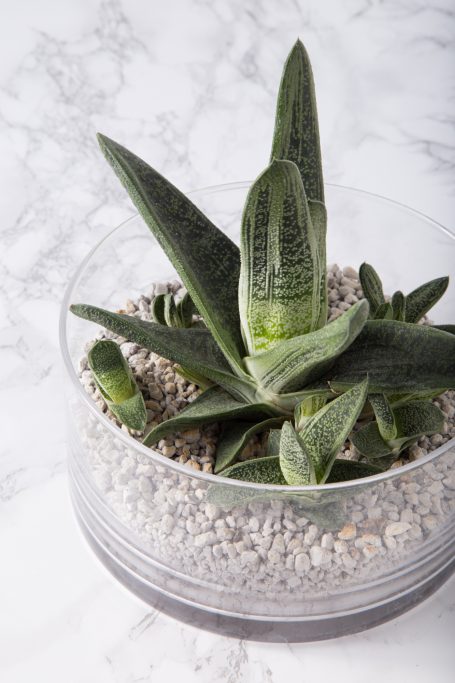
Adding larger materials to the bottom is a way that people frequently “add drainage” to a pot. However, this actually causes problems for succulents because it causes water to pool at the bottom of the pot. Then, the soil at the top of the pot traps the water in making it harder for the water to evaporate.
Using a consistent particle size, about 1/4″ (6mm) throughout your planter is the best way to allow water to evaporate quickly.
Watch how I water my succulents (including non-draining pots) in the video below:
Measure it out
One of the biggest problems with a non-draining pot is knowing how much water you've poured in. Glass containers are helpful because you can see the water level as you're pouring the water on.
However, this isn't the case with many non-draining planters.
I recommend measuring out the amount of water you pour on your plants.
You can do this a variety of ways. The simplest is to use a measuring cup, which you likely already have at home.
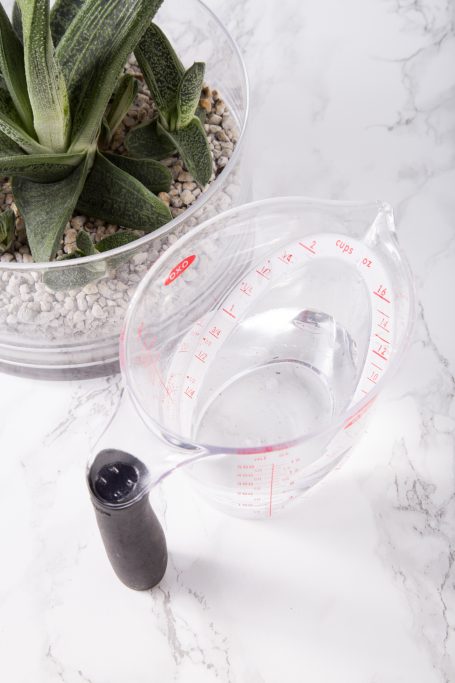
Another great option is this squeeze bottle from my favorite garden tools set. It has measurements on the side so you can see how much water is in the bottle.
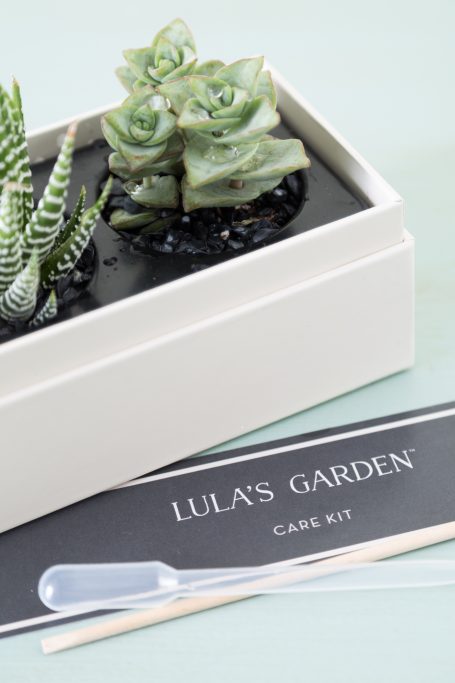
You can also use any sort of cup or even measuring spoons. The key is simply to pour on a designated amount of water. If you use your kitchen sink or a watering can, it's hard to know how much water your succulent is getting and it's easy to overflow the pot or give it too much water.
How much water
The trickiest part about watering succulents without drainage is knowing how much water it needs.
The goal is to pour on enough water that all the soil gets wet but avoid having excess water pool at the bottom of the pot.
If you happen to pour on too much water, you can use a rag or paper towels to try and absorb some of it. If your pot is fairly small, you may be able to pour the excess water off.

Different soil types retain different amounts of water, so even after you decide on an amount of water to give your succulents, you'll need to keep an eye out for symptoms of watering problems.
That said, I generally recommend pouring on water equal to half the volume of your planter. So, if your planter holds about a cup of soil, you'll pour on 1/2 cup of water.
Be sure to download the Succulent Tracker app (Apple | Android) to help you keep track of when you watered your succulents, how much water you added, when you repotted them, and more. It's been a lifesaver for my succulents!
Use this as a starting point and, again, adjust as needed based on what your plant tells you over the next few weeks. Both the amount of water you use and the frequency of watering will determine how healthy your succulent is.
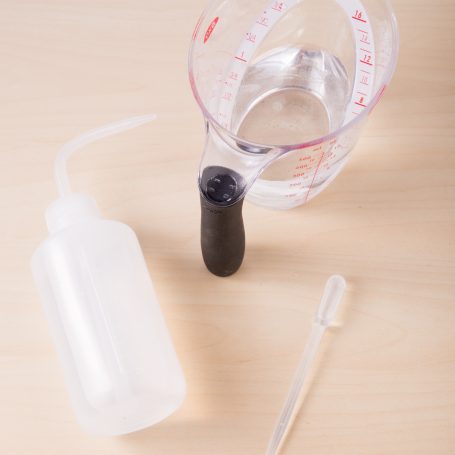
How often to water
I get asked this question over and over and the answer is simple:
Water only when the soil is completely dry.
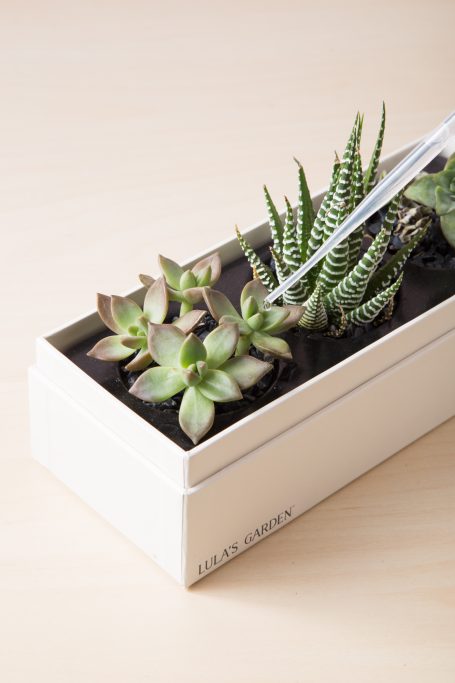
Watering on a set weekly or bi-weekly schedule doesn't always work out.
Watering when the soil is dry (rather than on a set schedule) is especially important for non-draining pots because the water doesn't dry out as quickly as it does in a pot with a drainage hole. This means your succulent has access to water longer and will likely survive with more time between watering.
That's why using the Succulent Tracker app (Apple | Android) is so helpful. You can record the date you last watered (so you don't have to remember) and it will calculate the average number of days between watering.
You won't have to guess how long ago you watered last and can set reminders for when you anticipate you'll need to water again.
Each succulent will have a slightly different schedule and there's a number of factors that contribute to their need for water.
Check out this quick video to see 5 factors that determine how frequently your succulents need to be watered: